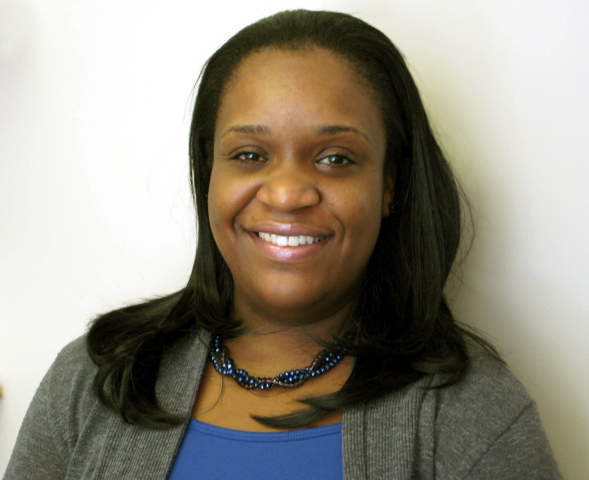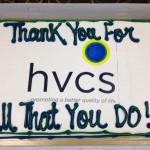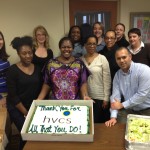HVCS just received word that we will receive a $2,500 grant from HPNAP (Hunger Prevention & Nutrition Assistance Program) to support our emergency food closet and Green Thumb food distribution program at the Mosaic Center in Mt. Vernon. This grant will allow us to continue to give stipends to peer outreach workers to assist us on Green Thumb food distribution days, which are typically the busiest of the month. Special thanks to our peers, Mosaic staff, and THRIVES nutritional program workers who do an amazing job getting fresh produce to hungry families so quickly!
Posts Tagged ‘News’
Thanks to HPNAP, Food Distribution Continues at Mosaic Center
Thursday, October 2nd, 2014Client Services Staff Appreciation Day
Friday, April 4th, 2014On Friday, April 4, 2014 the Client Services department (HVCS’ largest) held a morning staff meeting in our Newburgh office, followed by a pizza party luncheon and a beautiful cake. It was all to say “Thanks!” for all the great work they do all year long in the service of our clients. Great job, CS Department! (And I hope you saved some of that cake for us.)
Non-HIV Health Disparities Among the LGBT Population
Monday, January 27th, 2014The Henry K. Kaiser Family Foundation recently released an intriguing issue brief on LGBT healthcare entitled “Health and Access to Care and Coverage for Lesbian, Gay, Bisexual and Transgender Individuals in the U.S.” The report is chock-full of fascinating statistics from a variety of recent studies. Check out the full report for sources.
While there’s a lot of data on HIV, AIDS, and STI’s in the issue brief, the report also looked at other health disparities that impact the LGBT community.
- LGB people report more:
- asthma
- headaches
- allergies
- osteoarthritis
- gastro-intestinal problems
than heterosexual individuals.
- Gay and bisexual men report more cancer diagnoses and lower survival rates.
- Gay and bisexual men more cardiovascular disease than heterosexual men.
- Obesity rates are higher among lesbians than heterosexual women
- …but obesity rates are lower among gay men than heterosexual men
- Bisexuals have the highest smoking rates of any group in the US
- then lesbians and gays
- then heterosexuals.
See another recent study that shows that LGBT people spend more on smoking than any other group.
LaShonda DeCosta Promoted to Senior Program Supervisor
Monday, February 25th, 2013 LaShonda DeCosta has been promoted at Hudson Valley Community Services/ARCS to the position of Senior Program Supervisor for Putnam, Rockland and Westchester. DeCosta formerly served as the program supervisor for ARCS’ Rockland and Putnam offices. In her new role, she oversees medical case management, transportation, access to medical benefits, and Lower Hudson nutritional services. She has been with ARCS for over six years.
LaShonda DeCosta has been promoted at Hudson Valley Community Services/ARCS to the position of Senior Program Supervisor for Putnam, Rockland and Westchester. DeCosta formerly served as the program supervisor for ARCS’ Rockland and Putnam offices. In her new role, she oversees medical case management, transportation, access to medical benefits, and Lower Hudson nutritional services. She has been with ARCS for over six years.
DeCosta came to ARCS from Lakeside Family & Children’s Services in Rockland, working as a case manager for juveniles in group homes. She holds a BA in Deviant Behavior and Social Control from John Jay College of Criminal Justice in Manhattan. “My plan was to be a probation officer,” DeCosta said, “but I found that I wanted more. People living with HIV/AIDS face so much stigma, and I feel like I can make a real difference in their lives.”
Her upbeat and energetic personality assists her to empower the population she serves,” said Elizabeth Hurley, Assistant Director of Client Services. “LaShonda has proven to be a responsible and reliable professional on whom colleagues can always depend when extra assistance is needed. She was a natural choice for promotion to Senior Program Supervisor.”
Though she was a Rockland County resident for most of her life, DeCosta recently moved with her fiancé to Hackensack, NJ. She plans on marrying later this year.
The Down Side: NY Ryan White HIV CARE Network Disbanded
Wednesday, December 22nd, 2010On September 15, 2010 the NYS AIDS Institute announced that due to substantial budget cuts on the State’s Ryan White Part B funding, it was forced to close down the Ryan White HIV CARE Networks across the entire state. ARCS was the lead agency for the Hudson Valley’s network. Our contract with the state as lead agency will end as of December 31, 2010. Until then, the Network will continue to function as a comprehensive continuum of high quality services that is responsive to the needs of people infected with HIV/AIDS in the Hudson Valley. Network members, which include both HIV-positive individuals and representatives of service organizations, are making contingency plans and discussing what other steps might be taken to offset this loss. A course of action will be established and conveyed to members as soon as possible. ARCS deeply appreciates the dedication, hard work and accomplishments of the Network’s staff and members over the past three years.
Photos from Our Halloween Spooktacular!
Tuesday, November 9th, 2010Get all the latest news from ARCS by signing up for our monthly e-mail newsletter!
The current edition can be found here, hosted by the very generous Vertical Response email website. Check it out for a link to photos from our Halloween Spooktacular, snapped by volunteer Lorie Loupe!
Sign up to get your copy directly by visiting our homepage – then look for the yellow box on the lower right-hand corner!
October's E-news from ARCS
Wednesday, October 6th, 2010Get all the latest news from ARCS by signing up for our monthly e-mail newsletter!
The current edition can be found here, hosted by the very generous Vertical Response email website.
Sign up to get your copy directly by visiting our homepage – then look for the yellow box on the lower right-hand corner!
New programs at ARCS!
Wednesday, May 19th, 2010After two years of cuts to our core contracts by New York State government and the closure of long-standing programs, ARCS is pleased to announce the addition of four new services to its roster of comprehensive programs. Current funding priorities have focused on bringing underserved populations into the healthcare system, and ARCS is able to draw on its twenty-five years of experience and excellence to deepen our services to those in need.
Increasing Access to Care
Our new healthcare access and enrollment program, which began operating in November, reaches out to HIV-positive Hudson Valley residents who are not currently engaged by the healthcare system. Its main objective is to provide outreach and education to enhance early access to quality healthcare for HIV+ people of color, and to decrease disparities in health outcomes for minority populations. Two healthcare enrollment specialists, one serving the Mid-Hudson region and one operating in Lower Hudson, will outreach to 600 HIV-positive people to enroll them in ADAP (the New York State Department of Health’s AIDS Drug Assistance Program) and other healthcare coverage each year. “We want to let people know what health care options are available to them, especially those who think they don’t have options,” said Liz Lacy, ARCS’ Director of Client Services. “This program will not only connect underserved, low income minorities with medical care, but will also help them understand their test results, the importance of staying adherent to treatment regimens, and link them to other services ARCS can provide.”
Better Nutrition, Healthier Lives
In March, ARCS officially expanded its successful THRIVES Nutrition program from Orange, Sullivan and Ulster counties to the Lower Hudson region. THRIVES South will ensure that HIV-positive residents of Westchester and Putnam counties and their dependent children have access to nutritional foods that promote health and increase their ability to manage their HIV and the medical complications wrought by its treatment regimens. A nutritional coordinator teaches enrolled clients how to shop for nutritional foods, and supplies them with grocery vouchers to encourage greater independence and healthy food choices. Many clients receive prepared grocery bags from our Putnam Valley, Hawthorne, and Mount Vernon offices. The program also serves those who are home-bound and cannot make it to a supermarket by delivering bags of highly nutritious foods. To participate, clients must attend nutrition classes and are phased to more independent tiers over time. The program, which replaces our more traditional food pantry services, is also staffed by a program assistant. THRIVES South has already had more than 90 referrals for services, well on its way to meeting its annual goals.
How You Can Help
For decades, ARCS’ Westchester and Putnam offices were able to offer a traditional supplemental food pantry as well as a clothing “closet” filled with donated gently-used clothes and household items. Grants and donations from supporters, including a $15,000 legislative grant supplied by New York State Senator Andrea Stewart-Cousins and $5,000 donated by Nordstrom, enabled us to provide over 6,000 bags of groceries to our clients in 2009. In order to make room for the new THRIVES South nutrition program, ARCS was forced to discontinue its clothing “closets” and downsized our food pantry. Many of the former pantry clients will be enrolled in THRIVES, and the remainder will still be able to get supplemental groceries from our smaller food closet.
While our food services remain constant, we are no longer able to accept donations of clothing, household items, baby items, or furniture. However, we still need donations of non-perishable foods, toiletries such as shampoo, deodorant, soap, etc., and household cleansers including laundry detergent. To arrange for a donation drop-off or for assistance with organizing a food drive, please call (914) 345-8888.
Reaching Out to Disenfranchised Communities
ARCS’ newest program, Project Reach Out (PRO), aims to engage active substance users who are not currently in treatment and connect them to a variety of resources. PRO will operate out of mobile van in Orange, Sullivan and Ulster counties, primarily in those counties’ urban areas. A program supervisor, an outreach specialist and three peer educators will offer and encourage HIV testing, connect those who test positive or are already HIV-positive with extensive medical and support services, and encourage users, especially those who are HIV-positive, to enter recovery and addiction services. Staff will also offer needle exchange through the Expanded Syringe Access Program and health education. With a target of reaching 1,100 individuals, the PRO team will increase access to drug treatment for active users and increase awareness of users’ HIV status.
Community Health Alliance for Prevention Services: CHAPS
CHAPS will offer a broad array of services and activities organized around the needs and characteristics of young men who have sex with men (YMSM) living in the urban areas of Westchester County. We will focus our efforts on two sub-groups within this population, 16-18 year olds and 19-24 year olds. The program design includes a menu of interventions that are appropriate for each of these sub-populations. CHAPS will focus on targeted outreach in a variety of venues including the internet and on group interventions, individual level interventions, HIV and STD testing, and referrals to healthcare and other supportive services. The goal of the program is to reduce the growing rate of HIV and STDs among YMSM, and to improve their health and wellness by targeting knowledge, attitude and behavior.
To find out more about any of these programs, please call (914) 785-8326.
April is STD Awareness Month
Tuesday, March 23rd, 2010(from the CDC website)
April is STD Awareness Month, an annual observance to raise awareness about the impact of sexually transmitted diseases (STDs) on the health of Americans and the importance of individuals discussing sexual health with their healthcare providers and, if sexually active, their partners.
STDs are a major public health issue:
* CDC estimates that there are approximately 19 million new cases of STDs each year in the United States, almost half of them among young people ages 15 to 24.
* STDs have an economic impact: direct medical costs associated with STDs in the United States are estimated at $15.9 billion annually.
Vaccines offer protection against two common sexually transmitted viral infections: hepatitis B and Human Papillomavirus (HPV). CDC recommends their use for people at risk.
* While serious health threats from STDs cross racial and ethnic lines, disparities persist at too high a level.
* Higher rates of the most commonly reported STDs persist among African-Americans and Hispanics when compared to whites.
* Most STDs have been associated with increased risk of HIV transmission.
Many STDs do not have any symptoms, so many of those who are infected don’t know it. The only way to know for sure is to get tested.
The Importance of Testing
To reduce the impact of STDs, it is important to increase knowledge about sexually transmitted infections and make STD testing a part of routine medical care. Because many STDs have no symptoms, those at risk need to get tested and find out if they are infected.
Chlamydia is one of the most common STDs, especially among young women. CDC recommends that all sexually active women younger than age 26 get tested for Chlamydia once a year. Women who are older than 26-years-old should be tested if they have a new or multiple sex partners.
Getting tested and treated for Chlamydia can reduce new cases of pelvic inflammatory disease (PID) by over 50 percent, according to a study in a managed care setting. Women with PID can experience pregnancy complications, infertility, chronic pain, and irreversible damage to their reproductive organs. Reducing the impact of PID among women also requires men to be tested and treated for Chlamydia to reduce new cases. Recent studies have shown that many young women who have been diagnosed with Chlamydia may become re-infected by male partners who have not been diagnosed or treated.
CDC’s Sexually Transmitted Diseases Treatment Guidelines recommends that sex partners of infected patients be treated to prevent re-infection of the patient and transmission of the infection to others and those with Chlamydia be re-tested for the infection approximately three months after treatment. CDC also recommends that sexually active men who have sex with men (MSM) be tested for chlamydia, as well as syphilis, gonorrhea, and HIV at least annually.
Health care providers should take a sexual health history of their patients and follow up with appropriate counseling, vaccination, testing, and if needed, treatment for STDs. Increased prevention efforts, including screening, are critical to reducing the serious health consequences of STDs.
What You Can Do
* Talk with your doctor or health care provider about STDs and ask about recommended vaccinations and testing.
* Get tested. Visit www.findSTDtest.org External Web Site Policy to find STD testing locations near you.
* Talk openly and honestly with your partner about STDs.
Learn more about STDs, STD Awareness Month, and where you can find the nearest STD testing site in your area:
HIV Prevention Play Makes the Pages of POZ Magazine!
Monday, August 17th, 2009The next issue of POZ magazine will feature an article about Dan Gallagher, a former ARCS prevention educator, who wrote and produced a traveling HIV prevention play entitled “Between the Seams.” This short theatrical piece, aimed at adolescents, tells several stories from the perspective of HIV-positive teenagers who step out of their AIDS Quilt panels. “Between the Seams” travels to Hudson Valley high schools to dramatize the AIDS epidemic, and is able to emotionally connect teens with the realities of being positive. For several years, ARCS housed the “Between the Seams” program thanks to grants from the Dyson Foundation. The play is now produced by the AIDS Theater Project New York, and ARCS will provide funding for five performances this fall.
Congratulations, Dan!





